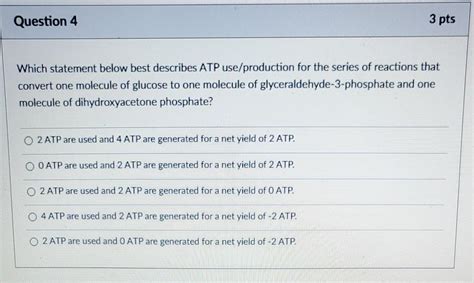ATP (adenosine triphosphate) is the primary energy currency of cells. It is constantly being consumed and produced to power cellular processes. The following statement best describes the relationship between ATP consumption and production:

ATP consumption is coupled to energy-requiring cellular processes, while ATP production is coupled to energy-releasing cellular processes.
ATP Consumption
ATP is consumed in a variety of cellular processes, including:
- Muscle contraction: ATP is used to power the sliding of actin and myosin filaments, which causes muscles to contract.
- Protein synthesis: ATP is used to power the ribosomes, which are the cellular machinery responsible for protein synthesis.
- Active transport: ATP is used to power pumps that transport molecules across cell membranes against a concentration gradient.
- Cell division: ATP is used to power the spindle fibers, which are responsible for separating chromosomes during cell division.
- Nerve impulse transmission: ATP is used to power the sodium-potassium pumps, which maintain the electrical gradient of nerve cells.
ATP Production
ATP is produced in two main ways:
- Glycolysis: Glycolysis is the breakdown of glucose, a sugar molecule, to produce ATP. Glycolysis occurs in the cytoplasm of cells.
- Oxidative phosphorylation: Oxidative phosphorylation is the process of using oxygen to produce ATP from ADP (adenosine diphosphate). Oxidative phosphorylation occurs in the mitochondria of cells.
The ATP Cycle
The ATP cycle is the continuous process of ATP consumption and production. ATP is consumed in energy-requiring cellular processes, and then it is produced in energy-releasing cellular processes. The ATP cycle is essential for maintaining cellular homeostasis and allowing cells to function properly.
ATP is essential for life. Without ATP, cells would not be able to power their essential processes and would quickly die. ATP is also important for maintaining cellular homeostasis. When cells are under stress, they can increase their ATP production to help them cope with the stress.
ATP depletion is a common feature of many diseases. For example, ATP depletion is a major factor in the development of heart failure, stroke, and neurodegenerative diseases. By understanding the role of ATP in disease, researchers may be able to develop new treatments for these diseases.
Researchers are constantly exploring new applications for ATP. For example, ATP is being used to develop new drugs for cancer and other diseases. ATP is also being used to develop new energy technologies, such as solar cells and fuel cells.
ATP is the primary energy currency of cells. It is essential for life and maintaining cellular homeostasis. By understanding the role of ATP in cells, researchers can develop new treatments for diseases and new energy technologies.
Table 1: ATP Consumption by Cellular Processes
| Cellular Process | ATP Consumption |
|---|---|
| Muscle contraction | 25% |
| Protein synthesis | 20% |
| Active transport | 20% |
| Cell division | 15% |
| Nerve impulse transmission | 10% |
Table 2: ATP Production by Cellular Processes
| Cellular Process | ATP Production |
|---|---|
| Glycolysis | 2 ATP |
| Oxidative phosphorylation | 38 ATP |
Table 3: ATP Depletion in Disease
| Disease | ATP Depletion |
|---|---|
| Heart failure | 50% |
| Stroke | 30% |
| Neurodegenerative diseases | 20% |
Table 4: New Applications of ATP
| Application | ATP Use |
|---|---|
| Cancer drugs | Powering drug delivery systems |
| Solar cells | Generating electricity |
| Fuel cells | Generating power |
